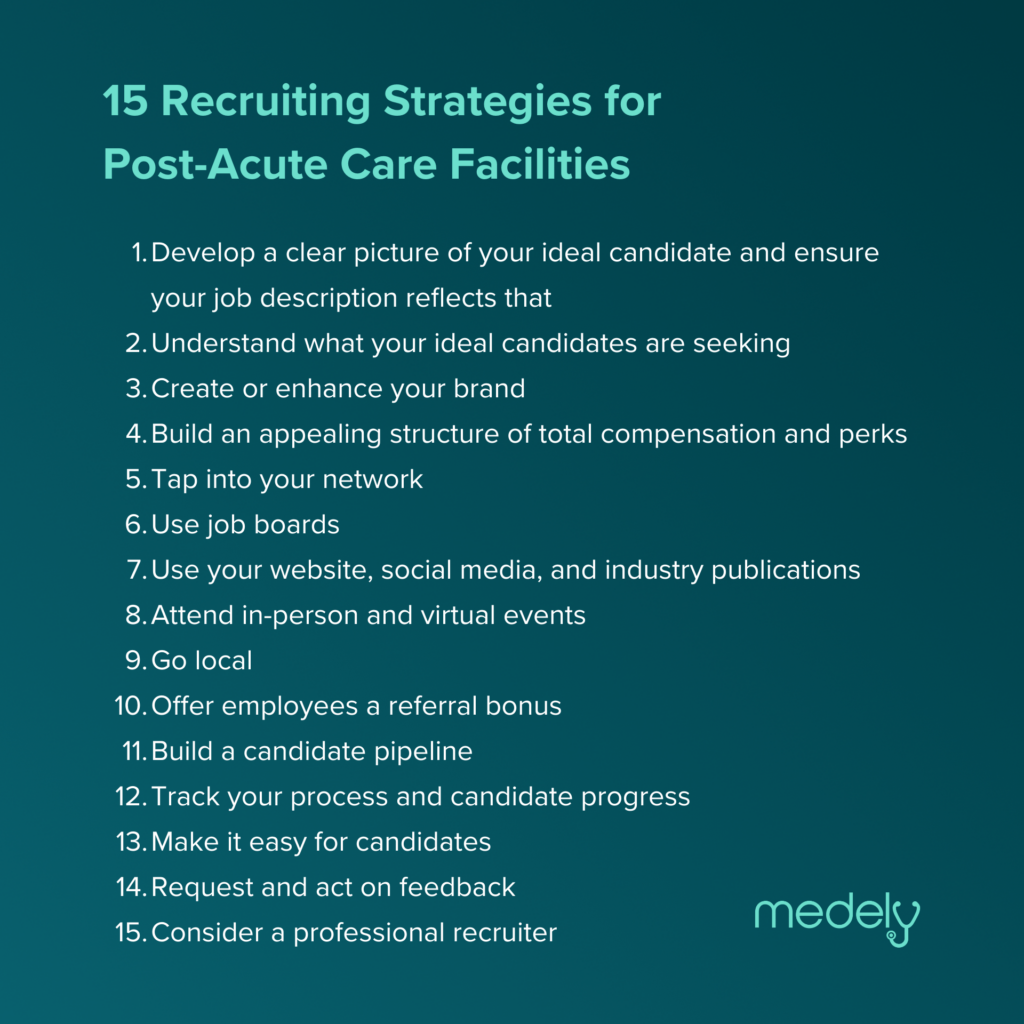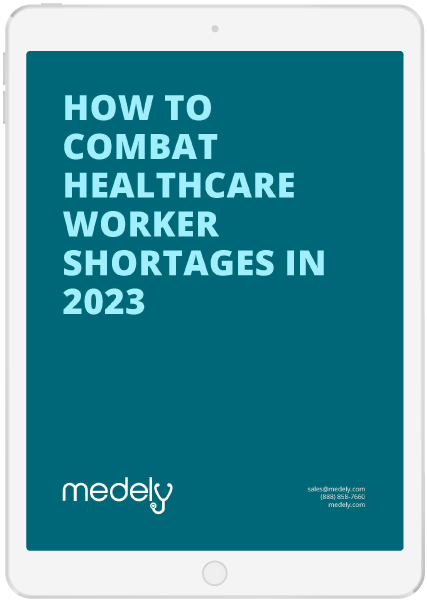Nurses are the heart of post-acute care facilities. Helping patients recover, regain physical function and quality of life after serious illnesses, and prevent more hospital care requires a special set of skills, competencies, and compassion. So, when a nursing position opens up in your facility, finding someone who truly fits your organization is no simple task. And, unfortunately, in the current climate of nursing shortages and burnout in healthcare, it’s not easy to find skilled, qualified nurses anywhere.
In this post, we’ll show you the best recruiting strategies for post-acute care facilities to find the skilled nurses you need to maintain the coverage you need and provide the best possible patient care.
First, let’s start with some stats.
Post-acute care spending in the U.S.
Post-acute care spending is about $2.7 trillion, including nearly 15% for Medicare. Clearly, it’s important that post-acute care facilities use their budget wisely, streamline their workforce, and implement creative strategies into their recruiting processes. Many post-acute care facilities use innovative staffing solutions like Medely to incorporate per diem nurses into their workforce to save money on expensive agencies, overtime, and recruiting processes. In fact, over 3,700 post-acute care facilities are using Medely right now. Click here to learn more.

Post-acute care demand is growing
The demand for post-acute care is growing in the U.S. as the population ages. Older Generation Xers and younger Baby Boomers now range between the ages of 48 and 78, and those aged 65 and older are expected to climb to 82 million by 2050.
The nursing shortage
In the middle of this growing demand is a lingering nursing shortage. Over 1M nurses were over 50 in 2022. By 2030, about 80,000 are likely to retire. Plus, many are burnt out from the lingering effects of the pandemic and the continued shortage of qualified nurses on staff at facilities across the U.S..
Thus, finding nurses is a tremendous challenge. It’s no longer enough to post your opportunity on online job boards and wait for responses to flood in. You need a broader, more creative approach.
Enhance your recruiting strategies for post-acute care facilities

1. Develop a clear picture of your ideal candidate and ensure your job description reflects that
Who are you looking for? What kind of person best fits your organization? Get your team together, including your current nurses, and describe the qualities of an ideal candidate. Think about technical skills, competencies, soft skills, and characteristics such as leadership, problem-solving, teamwork, dedication, and compassion. Use this list to write a thorough and authentic job description for what your team needs.
2. Understand what your ideal candidates are seeking
Flip your point of view. Consider what nursing candidates are looking for in a permanent position. Some, especially members of the younger generations (Millennials and Gen Z), are looking for a team environment, flexibility, and work-life balance. Providing these benefits can be the difference between skilled nurses choosing you over another facility.
You can also think about the challenges and pain points nurses are facing like lack of flexibility, low pay, and burnout. It could be that building recruiting strategies for post-acute per diem nurses to supplement your full-time staff is exactly what your organization and team need to sustain your workforce.
Learn more about how Medely helps post-acute care facilities stay staffed here.
3. Create or enhance your brand
In order to create a brand for your facility, you need to consider what your organization’s values, mission, and brand personality would be and think about how to communicate those elements to the outside world. Once you have those confirmed, you can create marketing messages that define your culture and how it relates to what today’s nurses and allied health professionals value most.
Showcase your facility’s brand message consistently on your website, social media, professional organizations and publications, and anywhere else nursing candidates spend time online. Videos can communicate a lot in a short amount of time to potential candidates. Think about creating one with your staff talking about the best parts of working with the team at your facility.
4. Build an appealing structure of total compensation and perks
Research and identify organizations that appeal to your ideal candidates. Investigate and find out what kind of compensation, benefits, and perks they offer. Do you need to make adjustments to be competitive? Consider these:
- Base salary
- Benefits
- Bonuses
- Pay differentials (for working second shifts versus weekends, for example)
- Flexible work hours
- Paying for staff development and education
5. Tap into your network
Tap into your personal and professional networks and friends and let people know you have a job opening. Use your personal accounts on social media platforms like LinkedIn and Facebook and post about what you’re looking for. Don’t limit yourself to people in the healthcare industry. Someone in your network might know the perfect nurse looking for a new opportunity. This is one of the best recruiting strategies for post acute care facilities because it allows you to find passive candidates and share the benefits of working for you. Also, you and the candidate will come highly recommended to each other by people you know and trust.
6. Use job boards
Online job boards — both general and industry-specific — are great resources but don’t think of them as your only option. These boards put your opening into a crowded field and will only give you active job seekers. But they can yield a lot of resumes.

How to effectively combat healthcare labor shortages in 2024
Learn how to effectively combat healthcare labor shortages with an extended workforce to maintain continuity of care and gain access to tools you can use to manage your extended workforce more effectively and efficiently. In this eBook, you’ll learn:
- ■ Why nurses are leaving full-time jobs behind.
- ■ The factors impacting healthcare professional employment.
- ■ How you can use an extended workforce to meet demand.
- ■ How you can use data-led staffing planning to manage costs.
7. Use your website, social media, and industry publications
Post your job opening on your facility’s website, any social media where your target candidates spend time, and industry publications candidates are likely to read. That way you’re creating awareness around the open role you need to fill.
Another effective strategy is to use these channels to post consistently about your patient care, your team, and any innovative updates your facility is tackling that people might be interested in. Bringing the spotlight on everything your facility is doing for your patients, team, and community will draw more nurses in on their own.
8. Attend in-person and virtual events
At job fairs, conferences, and networking events, you can meet candidates face-to-face and have informal conversations. Both you and your candidates get a preview of each other and a hint of whether some may be a good fit for your organization.
9. Go local
Your surrounding community can be the best recruiting grounds for your facility. Community centers, coffee shops, places of worship, and other gathering places have bulletin boards, websites, and newsletters where you may be able to post your jobs. You could even consider giving a presentation to these organizations to educate their audience about what your facility does and the way you improve patients’ lives.
10. Offer employees a referral bonus
Consider establishing a formal employee referral program with rewards and incentives for bringing in a candidate. An important resource for your recruiting efforts is right in front of you – your current employees. They have networks of their own. Chances are, they know someone who might want to apply or who can recommend great candidates, and they’d be more likely to seek those people out if they were getting incentivized to do so.
11. Build a candidate pipeline
Using so many resources will hopefully result in a large pool of qualified candidates. These are people you want to stay in contact with, so it’s a good time to create a candidate pipeline. Ideally, you will have some knowledge of these candidates before you start interviewing, and they will know about your organization and brand, and you can keep these candidates in mind for any future roles if they aren’t the right fit for what you are currently looking for.
Medely currently has over 300K nurses and allied health professionals in their network. You can tap into their candidate pipeline whenever you need to fill an open position, and we’ll handle the credentialing, scheduling and billing, all from our platform. Plus, you can Favorite people to keep them coming back. Learn more here.
12. Track your process and candidate progress
Make sure that you are tracking the status of each candidate through all the steps in your recruiting process. Also, track the process itself. Metrics such as the number of new candidates this week or month, the time it takes to get from initial application to hire, and points in the process where you may be losing candidates will help you evaluate and improve your process the next time.
13. Make it easy for candidates
Each step of the recruiting process should be easy for candidates to navigate. Finding and completing an application form, submitting a resume, scheduling interviews, and getting questions answered should all be a breeze for candidates. If they contact you with questions, respond immediately. You certainly don’t want to lose their interest to a competitor.
If you’re looking to recruit per diem nurses, Medely makes it easy. Learn more here.
14. Request and act on feedback
There is always room to improve your process, especially when you ask for feedback. Send a brief survey to candidates who have completed your recruiting process (successfully or not). Those who choose to participate offer valuable information from the candidates’ point of view. Both positive and negative responses can lead to a more streamlined process for future job openings.
15. Consider a professional recruiter
Successful recruiting strategies for post-acute care facilities take a great deal of time, effort, and knowledge. If you find it challenging to recruit in addition to your normal responsibilities, a professional recruiter may be a good alternative. Many recruiters specialize in the healthcare industry and are fully focused on the process. They have built extensive networks and other resources that give them access to a large candidate pool; plus, they can pre-screen candidates and send you only the best of the bunch.
Staffing solutions like Medely act like a recruiting service, bringing in health professionals from all over the country and presenting credentialed, verified nurses and allieds to you all on our platform.
Conclusion
Use these recruiting strategies for post-acute care facilities strategies for recruiting in this tough job market to find the nurses and allied health professionals you need. Then, turn ideal candidates into the best nurses for your team and your patients.
If you’re having a hard time finding and allocating budget for recruiting and retaining permanent staff, Medely can help. Medely empowers post-acute facilities to build and manage a sustainable, modern workforce. Our innovative technology helps facilities seamlessly connect with our networking of over 300K verified nurses and healthcare professionals, to cut agency and overtime costs, reduce churn, and secure full coverage. Find out more here.



